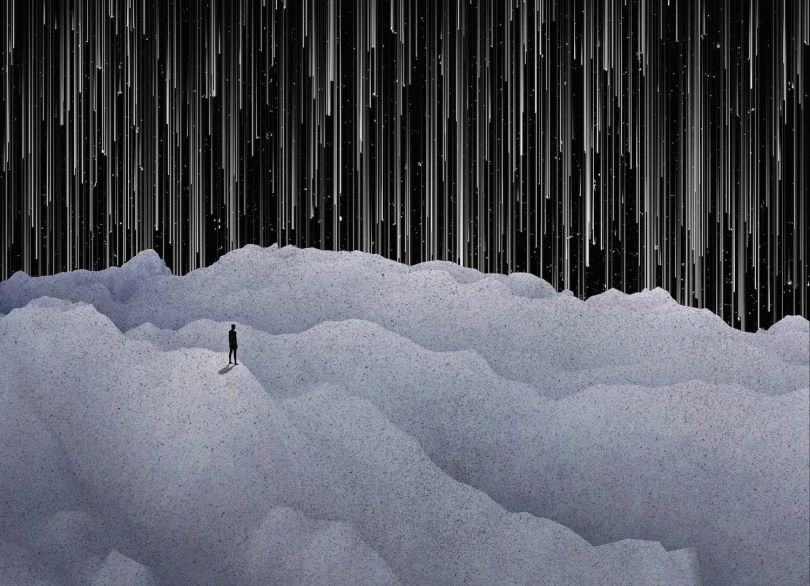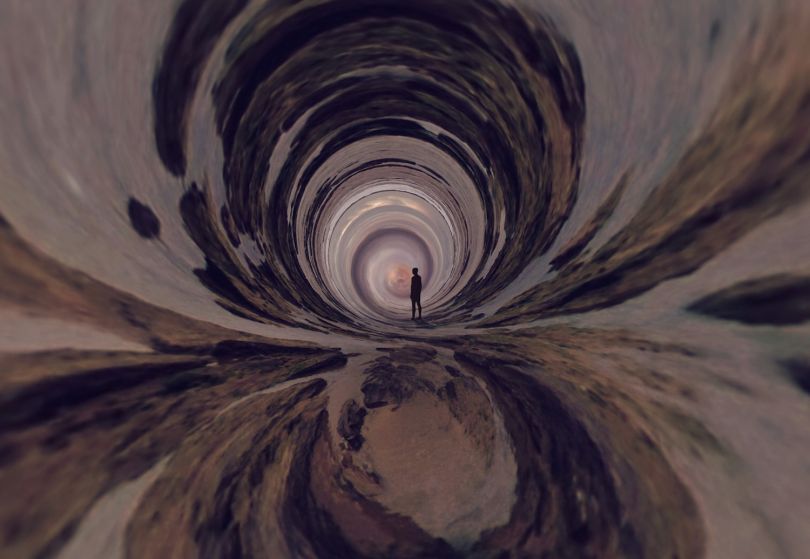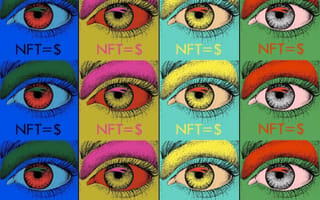NFTs are not only one the latest examples of a tech gold rush, but they represent a potential disruptor of the design and art world. Synth-pop artist Grimes has sold millions of dollars of digital artwork as NFTs, while Twitter founder Jack Dorsey sold a signed copy of his first tweet — “just setting up my twttr” — for nearly $3 million. Even filmmaker Quentin Tarantino announced plans to release Pulp Fiction-related NFTs tied to unreleased scenes.
Since 2014, NFT art has spanned across digital marketing, gaming, music and everything in between. But what’s the significance of NFTs in overall media creation today? Here’s what designers and artists should know about the medium and where the NFT market is heading.

What Is NFT Art?
What Is NFT Art?
NFTs live on a blockchain and can be attached to anything — images, videos, tweets. A unique string of encrypted code signifies an NFT as authentic with a secure record of ownership. Once “minted,” the digital object — often a 3D image or animation — can be stored in an owner’s digital wallet and sold at auctions for cryptocurrencies like Bitcoin and Ether.
Much like traditional works of art, the value of NFTs is derived not only from their artistic merits, but their verifiable proof of origin. There are countless posters and digital photographs of The Mona Lisa, but most are worth next to nothing. Leonardo Da Vinci’s old master on permanent display in the Louvre, however, is believed to be worth $850 million. That’s because it’s not a simulacrum; it’s the bona fide original.
The same idea of scarcity-based value holds true in theory and, at least right now, in practice for NFTs. One of the bullish ideas collectors attach to the exclusive digital objects— which, in file form, can be little more than a JPG or GIF validated with a string of text in a hash or link — is that verifying the provenance of digital artwork using blockchain increases its market value and reduces piracy threats.
NFTs signify ownership, but the copyright often remains with the creators. So while you can reproduce the works endlessly, on certain projects, the owner of the NFT has something that is, at least notionally, unique.
“It’s proof that this item only exists once,” Felix Holzapfel, founder of digital marketing agency conceptbakery and author of several marketing and digital media books, said. “If you take Andy Warhol or more modern artists, it’s easy to replicate their art. And the more popular the art gets, the more valuable the original artwork gets.”
Holzapfel gets it: In 2021, he teamed up with digital and crypto artist Nate Hill to make an exclusive NFT package containing the cover artwork for a new novel Holzapfel had authored. The two held a reverse auction for the book and art bundle on SuperRare, one of the leading marketplaces for cryptoart. The NFT package sold for 3 Ether — equal to $7,421.76 on the day of the sale.
How to Design NFT Art
The term “NFT design” may be a little misleading. NFT artists and designers don’t exactly design NFTs. They create digital artworks, just as they did before the blockchain existed. Then they mint and sell NFTs that are linked with those pieces of art, acting as a digital record of ownership. Here’s a quick primer on the steps involved:
1. Set Up A Crypto Wallet and Buy Cryptocurrency
To pay a platform to mint an NFT, you’ll need to first have the cryptocurrency basics in place. Crypto wallets don’t exactly “store” money — they house encryption keys associated with digital assets — but they are the interfaces that allow you to retrieve, send and receive cryptocurrency.
There are many options for both wallets and currency, but newcomers probably want to start with the popular MetaMask for a wallet and should definitely start with Ethereum (the go-to cryptocurrency for NFTs), respectively.
2. Connect Your Crypto Wallet to an Auction Platform
Once you have some crypto and a wallet, you’ll need to tie it to the auction platform you plan to use. The interaction design on most platforms makes this easy. For example, at popular auction platform OpenSea, users hit the “Profile” button at the top-right (here’s a visual) and then are quickly prompted to connect their wallet.
3. Create and Sell Your NFT
Once your wallet is connected, you’re ready to create an NFT. The process is straightforward: It essentially means you upload your design as a file. Just mind the file size and format requirements, and note that many platforms will ask you to also create a “collection,” where the NFT is hosted and prices and trade volume are listed. Different customization options are available depending on the platform, but those are the basics.
From there, you can sell. Again, the precise details and user flows vary by platform, but be prepared to input your floor price, list how long the auction will run, note whether or not you want to bundle multiple tokens into a sale and be aware of any potential fees the site may incur.
How NFTs Turn Cryptocurrency Investors Into Cryptoart Collectors
For many, initially investing in cryptocurrency or just one cryptoart piece has become the gateway into the larger world of NFTs.
According to Hill, who formerly made a living from photography and album cover design, sales of NFTs on platforms like SuperRare, Rarible and OpenSea have become a full-time job that “set me and my family up very well,” he said.
How well? Since beginning sales, he has sold more than 1,600 pieces, with his top seller fetching $18,000. DJ and producer 3LAU (Justin Blau) introduced him to the space after the two met on Instagram, where Hill cultivated a large following for his work and beta-tested several of the platform’s popular photo-editing apps.
In a burgeoning cryptoart market that has seen NFTs sell for jaw-dropping sums of money, Hill is hardly alone in his success. After two weeks of bidding at the auction house Christie’s, the graphic designer Beeple sold his digital collage “Everydays: The First 5000 Days” to Metakovan, the Singapore-based founder of the cryptofund Metapurse, for $69.3 million, more than any painting by Titian or Raphael, according to The Washington Post.
“There are a lot of collectors that I think have probably gotten rich off cryptocurrency and are enjoying this technology and the art coming into the space,” Hill said. “It’s a lot like social media, to be honest. It seems to be where all the tech people and crypto people are.”
Social reciprocity and active involvement in the NFT community — which, in many ways, is its own self-fulfilling hype beast — appears to be a winning strategy.
“Community is a huge part of it,” Hill said. “The major collectors want to see that you’re not just coming in to drop a piece of paper, a couple pieces of art, and out for a quick cash grab. They want to see that you’re investing in the space and sharing about it with other artists, that you believe in this as a medium and as a way to create, and earn a living off, your art.”
NFT Art Faces Criticism and Conflicts Over Ownership Rights
Of course, the NFT community has its share of outspoken critics. A group of digital artists protested when indie developer Jason Rohrer created an NFT auction called “The Crypto Doctrine” using paintings he commissioned from them in 2012 — well before NFTs were created — to use in a burglary game called “The Castle Doctrine.” Though there were no written contracts issued when the paintings were obtained for the game, several of the artists complained that their works were appropriated under false pretenses.
“I am not a fan, to put it mildly, but am deeply opposed to the current trend towards artificial scarcity of digital objects, for numerous reasons,” game creator and scholar Andy Nealen was quoted in an interview with Kotaku. Nealen cites what he called the “unprecedented environmental damage” caused by the massive electric power required to run blockchain transactions.
“They want to see that you’re investing in the space and sharing about it with other artists, that you believe in this as a medium and as a way to create, and earn a living off, your art.”
Another gripe is that NFT art is not real art, but a chintzy derivative, “one more riotous example of high-roller groupthink, market manipulation and the seemingly unstoppable human urge to commodify everything,” as critic Sebastian Smee not-so-mildly put it in The Washington Post.
Then there’s the issue of the ephemeral quality of NFTs. Where does their value actually lie?
How Is NFT Art Valued?
Like any artwork over time, the value of NFT art varies — but at a more unpredictable rate due to the fast-paced nature of the internet. Liquidity, rarity and popularity all go into play for how much an NFT will cost, leading to steep and ever changing fluctuations in the market. NFT market capitalization grew to over $17 billion in 2021, making for increasingly stiff competition for rare NFTs. Conversely, NFT sales saw a large drop in mid-2022, down 97 percent since January 2022.
Holzapfel believes criticism of the art itself reeks of the same sort of gatekeeper snobbishness that snubs its nose at, say, electronic music or vernacular architecture.
“It’s a different type of creativity that these artists use,” he said. “They hack tools to import filters and combine files. It’s not so different from taking an oil painting and putting chalk into it to change the structure. It’s just a different type of creativity that we need to get used to, to value it in the same way we used to value traditional arts.”
Criticisms of the value of NFTs are equally misplaced, he argues. Their trade is not so different from traditional art sales: NFTs are sold directly from platforms that operate like storefronts, through open-bid auctions or in “reverse” auctions that typically provide a 24-hour window to up a starting minimum bid. While scarcity is artificially engineered, collectors buy cryptoart for the same reasons they buy other art: because they admire it or expect its value to appreciate over time — or probably a little of both.
“Everybody asks the same questions: ‘Okay, give me a break. So you sell the JPG, which is basically the artwork, for $7,500. Couldn’t everybody just download the high-resolution artwork and print it?’” Holzapfel said.
Yes.
And isn’t it the same JPG?
Excluding the password and ownership record, yes.
And can’t it be easily reproduced on Twitter, TikTok, Instagram, et cetera?
Again, yes.
But none of this really matters — their currency on platforms like Twitter, where Hill promotes his work, may explain why brands like Nike and Taco Bell are selling them to customers, and musicians like Kings of Leon are releasing NFT albums.
“From the perspective of the value of that NFT, as more people print that JPG and put it on their wall or do something with it, the value of the NFT goes up, because it proves that more and more people love that image and that it’s a great image,” Holzapfel said.
“Everybody asks the same questions: ‘Okay, give me a break. So you sell the JPG, which is basically the artwork, for $7,500. Couldn’t everybody just download the high-resolution artwork and print it?’”
Popularity, in other words, confers value. But becoming popular requires more than just talent. Almost all major NFT selling platforms are selective in which artist they work with, Hill said, and some do significantly more trade volume than others.

The Future of NFT Art, Design and Use Cases
With the NFT boom, some tech companies are rushing in with the stated intention to make NFT transactions easier and more realistically accessible. In 2021, NFT provider ViciNFT designed and issued an NFT for writer Victor Villaseñor’s book Burro Genius. The art bundle, featuring a childhood picture of the author and a handwritten quote inspired by Villaseñor’s grandmother, sold for .225 Ether, or roughly $793 at the time, on OpenSea, with 25 percent of proceeds donated to environmental charities.
NFT art still has a ways to go to completely break into the mainstream, but holds promising outcomes for physical media and real-world instances.
While some of Hill’s graphic-design friends have done quite well selling their work, others have floundered, particularly as the market has grown more saturated, he said. His advice to those starting out is to build slowly, releasing small batches of exceptional work with the best chance of drawing eyeballs on social sites or NFT marketplaces.
“[For artists], try not to jump in and put lots of artwork up all the time, but start small, and see if you can make a sale,” Hill said. “I’ve seen some artists come in and mint like 15 pieces of art that they’ve made in the past. And none of them sell. Because none of them sell, collectors sort of think, ‘Well, why would I invest in that if no one else is interested?’”
Of course, books operate differently than isolated images and raise a whole new set of questions regarding copyright protection. Holzapfel acknowledged that a lack of clarity surrounding digital rights management (DRM) is one of the teething problems of NFTs, particularly as it pertains to the publishing trade.
“Try not to jump in and put lots of artwork up all the time, but start small, and see if you can make a sale.”
While reading platforms like Kindle and Apple iBooks have DRM controls that prevent unauthorized file sharing, the protection doesn’t exist on most messaging apps. That “probably would hold back larger publishers from using NFT technology,” Holzapfel told me, as they couldn’t control the manuscript’s spread.
But for a copyright holder like a self-published author, unauthorized file sharing might not be such a bad thing. As boutique publishers and authors not represented by large publishing houses look for new ways to promote and sell their work outside traditional channels like Amazon and Barnes & Noble, NFTs could become a viable marketing tool and alternative income stream. Plus, smart contracts could give the copyright holders access to a cut of secondary markets — like resold books. Remember how Amazon built its empire?
“There are a lot of big players in the market right now who you need to go through, and there will be no need for that anymore. People can start to deal between themselves,” Holzapfel said.
Like Villaseñor’s book, Hozapfel’s book launch included a similar aspect of charitable contributions. The author auctioned NFTs containing the novel and a limited-run poster of the book’s cover, with proceeds from the sale being donated to Paradigm Initiative, an NGO that promotes digital inclusion in Africa.
“It’s not about earning money,” he said. “It’s more about showcasing what type of things you can do with NFTs: What type of specials you can create, how you can use smart contracts to distribute the profit to different players.”
“The bar to read a book is quite high. So by creating something like an NFT campaign for a book in the stage where the market is right now, I give people another opportunity to talk about my book.”
But that’s only partially true. Holzapfel acknowledged he also wants to make money on the novel, and interest in the artwork and charitable campaign could increase its chances of being read and reviewed by critics.
“The bar to read a book is quite high,” he said. “So by creating something like an NFT campaign for a book in the stage where the market is right now, I give people another opportunity to talk about my book, without the need to read my book.”
Looking back, Holzapfel said the enterprise felt like a strong showcase of how blockchain tech and publishing can work hand-in-hand. The original NFT bundle sale was a success, his experience with smart contracts went swimmingly, and he got “a really beautiful cover for my book, which usually would have cost me tons of money, for free,” he said.
Interestingly, the book itself has little to do with NFTs. An amalgam of the mystical number 42 in Hitchhiker’s Guide to the Galaxy and Joseph Heller’s satirical war novel Catch 22, the title — Catch 42 — reflects humans’ ability to “think the unthinkable and make the impossible possible,” Holzapfel said.
For those banking on NFTs’ success, hopefully life imitates fiction.
Stephen Gossett contributed reporting to this story.




